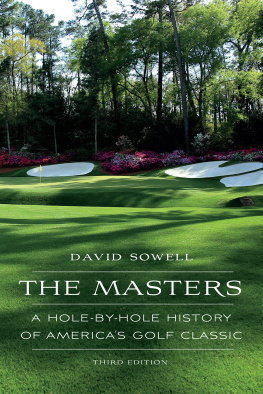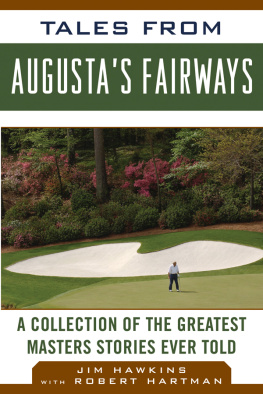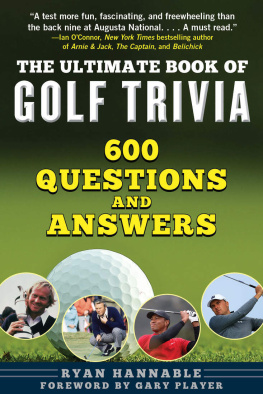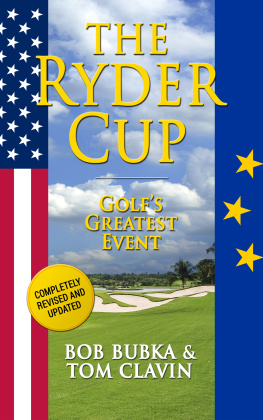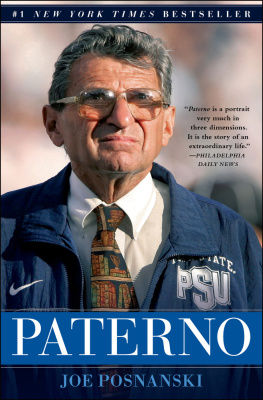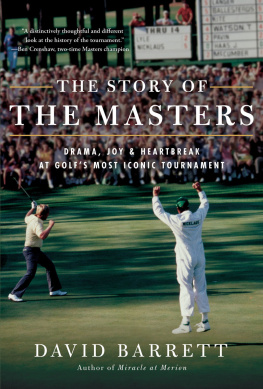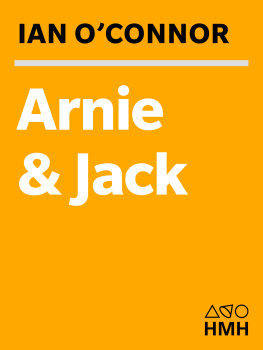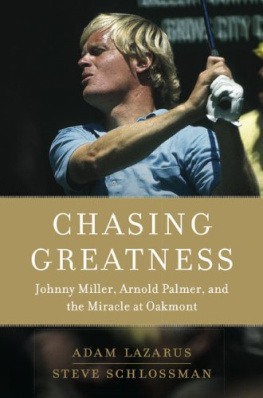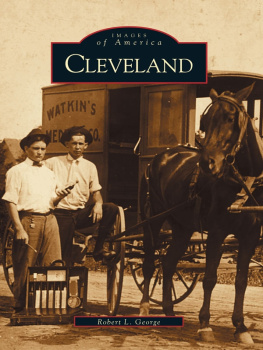STERLING and the distinctive Sterling logo are registered trademarks of Sterling Publishing Co., Inc.
Library of Congress Cataloging-in-Publication Data Available
10 9 8 7 6 5 4 3 2 1
Published by Sterling Publishing Co., Inc.
387 Park Avenue South, New York, NY 10016
2010 by Sterling Publishing Co., Inc.
Distributed in Canada by Sterling Publishing
c/o Canadian Manda Group, 165 Dufferin Street,
Toronto, Ontario, Canada M6K 3H6
Manufactured in the United States of America
All rights reserved
Sterling ISBN 978-1-4027-6629-9
For information about custom editions, special sales, premium and corporate purchases, please contact Sterling Special Sales Department at 800-805-5489 or specialsales@sterlingpublishing.com.
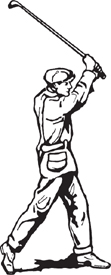
M y introduction to the U.S. Open actually began at the Concord Country Club in Concord, Massachusetts, which never came close to hosting the Open.
I began caddying there in 1963, became caddie master a few years later, and then worked for many years as an assistant to the longtime club professional, Harold Cahoon. Harold became friends with Bobby Jones, who was studying at Harvard following the end of his competitive golf career in 1930, the year he completed the unprecedented Grand Slam by winning the U.S. and British Opens and Amateurs. Jones was never particularly comfortable with his celebrity and liked to come out and play Concord because no one ever bothered him. Through Harolds stories, I came to appreciate Jones both as a competitor and as a person of uncommon grace and character.
Harold was also a close friend of Francis Ouimet, who, as a nineteen-year-old amateur, beat Harry Vardon and Ted Raythe great British professionals of the dayin an eighteen-hole playoff for the 1913 U.S. Open at the Country Club in Brookline, Massachusetts, where he had learned the game as a caddie. He was also the winner of two U.S. Amateurs (the first player to win both an Open and an Amateur), played on eight Walker Cup teams, captained two others, and was the first American to serve as captain of the Royal and Ancient Golf Club of St. Andrews.
One blazingly hot and humid summer day in 1964, Harold telephoned me at home and asked me to come right over to the club. He said he had a doubles loop for me with Mr. George K. Whitney and a guest. Now, you should understand that Mr. Whitney was the ideal person to caddie for. Generally, hed show up at 1 p.m. with his wife, Una, and theyd go out. They raced around the coursetypically it would take them under three hours depending on how many groups they played throughand he always gave his caddie a crisp ten-dollar bill, this at a time when an A caddie got three dollars a bag.
I arrived at the pro shop and was introduced to none other than Francis Ouimet, a dear friend of Mr. Whitney and still very much a hero in the Boston area. I remember vividly that Mr. Ouimet had a small leather golf baga blessing given the heat and humidityand he had a set of Spalding Elite irons that had been given to him a year earlier to commemorate his victory in the Open fifty years before. They were beautiful clubs that had his signature engraved on each one. On the soles of the irons, instead of numbers, they had old-fashioned names like niblick, mashie niblick, and so on.
Mr. Ouimet was seventy-one at the time, but he still played beautifully. What I remember was his interest in me and his kindness. He asked about my golf game (mediocre) and how I was doing in school (ditto). When we finished, he shook my hand, apologized for not playing better, and thanked me. The pleasure was all mine.
It is said that there is no such thing as a bad Open, and I suppose thats true. But having said that, I must add that there are some Opens that are better than others. Certainly Harry Vardons victory in 1900 would count, since he was arguably the best player in the world at the time. Ouimets win in 1913 was one for the ages since he was the first native-born American to win the national championship and was a person of both modesty and grace. Walter Hagens wins in 1914 and1919 make the list because he was Walter Hagen. The same goes for Gene Sarazen in 1922. Any Open Bobby Jones won is likely to be on everyones list, but his playoff win over Al Espinosa at Winged Foot in 1929 is almost certainly a lock because he sank an impossible putt on the seventy-second hole to get into a playoff. In the years since, thousands of players have concluded their rounds on the West Course by trying to replicate Joness feat. Few have. His victory at Interlachen in 1930 was crucial since that was the year he completed the Grand Slam.
Moving into the modern era, youd have to count Byron Nelsons victory in 1939, since it was his only win in the Open. The Bobby Jones Rule absolutely applies to Ben Hogan, who won his first of four Opens in 1948 at Riviera. By his own admission, his most emotional Open victory came in a playoff at Merion (most peoples sentimental favorite among Open courses), since it marked his comeback from a near-fatal automobile accident, but his greatest Open win may have come in 1953the year he won the Masters, the Open, and the British Openbecause it came on a brutally difficult Oakland Hills course.
You will notice one name that is glaringly absent from discussions of great Opens: Sam Snead, who never won the Open but finished second three times. That the Slammer never won the Open is one of the games saddest asterisks and most enduring mysteries. He often compared the Open to the girl that got away, and his failures haunted him.
Tommy Bolts win in 1958 was immensely popular among the writers because he was always good for a quote. Witness this gem: After the first round, Bolt confronted Tom Lobaugh, who was covering the Open for the local TulsaWorld, and complained because Lobaughs story had given Bolts age as 49 instead of 39.
Sorry, Tommy, said Lobaugh. It was a typo.
Typo my ass, said Bolt. It was a perfect four and a perfect nine.
Tommy Bolt was beautiful.
If writers liked Tommy Bolt for his quotes and all the great anecdotes associated with his name, they absolutely loved Arnold Palmer for simply being Arnold Palmer.
Arnold Palmer won just one U.S. Open, but it was a thing of beauty. The year was 1960 and the place was Cherry Hills Country Club near Denver. All Palmer did was go out and shoot a 30 on the front nine of the final round and then outduel an aging Hogan and a nineteen-year-old amateur of promise named Jack Nicklaus on the inward nine. The betting here is that Palmers victory would make anyones top five list of the greatest U.S. Opens.
In true Palmer fashion, his losses were often as dramatic as his wins. He finished second four times, with three of those coming in playoffs, one of them to Nicklaus in 1962 at Oakmont Country Club near Pittsburgh, Palmers backyard.
Like Hogan, Nicklaus was the perfect Open player. He won four Opens and was runner-up in four others. There were many reasons for Nicklauss success in the Open, but the biggest might be that he loved the pressure. He always said that he had an advantage in the Open because once the USGA ran up its flag, he felt two-thirds of the field choked themselves out of contention. The record suggests he was probably right.
Two other players who enjoyed being in the cauldron that is the U.S. Open were also two of Nicklauss greatest rivals, Lee Trevino and Tom Watson. Trevino won two Opens, one at Merion, where he beat Nicklaus in a playoff, and the other at Oak Hill, where he was the first player to shoot four rounds in the 60s. Watson won the 1982 Open at Pebble Beach in dramatic fashion, chipping in from the rough on the seventy-first hole to edge Nicklaus by two strokes.
Next page

